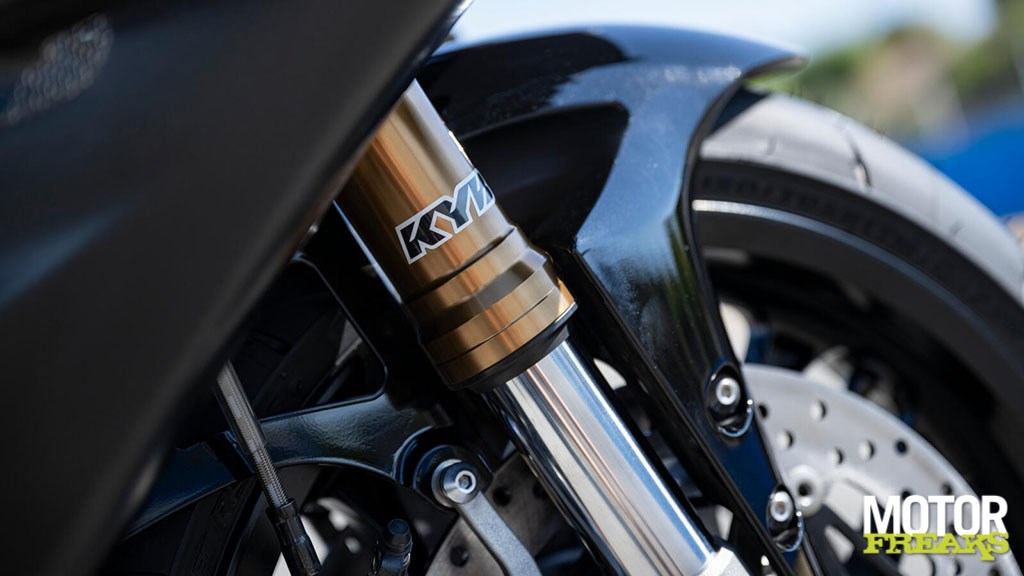Yamaha has given the YZF-R1 a major update for model year 2025. So far the good news. Just like the current model, the 2025 edition will only be available in Europe as a track-only, because the costs of adapting to Euro5+ do not outweigh the benefits.

You don’t need to tell us that racing is in Yamaha’s DNA, the brand had barely been founded in 1955 when it took part in the very first motorcycle race. With the Y-A1 – the very first Yamaha – it took part in the Mount Fuji Ascent Race, a race that it also won straight away.
Since then, the necessary successes have been achieved at national and global level in the Grand Prix road racing and the WorldSBK. In the first years of that WorldSBK with the super exclusive FZR750RR OW01, which was followed by a more affordable YZF750SP. However, the great success did not come, whereupon Yamaha went on the exclusive tour again with the YZF-R7, with which Haga could (and actually: should) have won the world title, if it had not been for a dubious doping scandal for which he was suspended for several races.
The YZF-R7 was the second model in the new YZF-R family, the first model being the YZF-R1, which was launched in 1998. The YZF-R1 was a huge success, just like Honda’s Fireblade had been in 1993. Or rather, it surpassed it. However, it would take until 2009 for the R1 to make its breakthrough in WorldSBK, and how. American Ben Spies dominated the season, giving Yamaha its first WorldSBK riders’ and constructors’ titles.
The 2009 YZF-R1 was the first R1 to feature a crossplane inline-four, a fancy term for a crankshaft with offset crankpins, which gave the R1 the feel and sound of a V4 – a concept that Yamaha had already pioneered in MotoGP a few years earlier and continues to use today on both the R1 and the YZR-M1 MotoGP racer. In 2015, the R1 was given the same styling as the MotoGP racer.
Since 2015, the R1 has won one WorldSBK world title, two EWC world titles, eight All Japan Road Race championships, eight MotoAmerica titles, three BSB titles and two IDM Superbike championships. And to this day, the R1 continues to fight for podiums and victories in the WorldSBK and EWC championships, as well as title glory in various national series.

The sharp decline in sales figures in the Supersport segment made Yamaha decide a few years ago to market the R1 in Europe only as a track-only bike, because it was no longer profitable to adapt the engine to the increasingly strict environmental requirements. In parts of the world with less strict requirements, the R1 (as well as the R6) remained available, in our Europe it became the R1 RACE – purely and exclusively for the circuit.
The most striking feature of the 2025 R1 RACE are the aerodynamic winglets, which have been designed and developed based on technical feedback from the Yamaha Factory Racing MotoGP team. According to Yamaha, the winglets should maximize the effects of the anti-wheelie electronics and improve the feel and feedback at the front end during braking and turning. Made of carbon fiber, of course.
In addition, Yamaha has completely redesigned the 43 mm KYB upside-down front fork, with the damping now separated: on the left the compression damping and on the right the rebound damping, both adjustable for both hi-speed and low-speed damping.
Each fork leg now features a base valve, designed to optimize cylinder pressure by reducing or eliminating oil flow to the bottom of the fork. This new layout has resulted in improved damping, feel and stability, according to Yamaha. In addition to the new forks, Yamaha has also improved the brakes, which now feature Brembo Stylema monobloc calipers and a Brembo radial master cylinder.






Yamaha has also made some changes to the 998cc CP4 inline-four, although these have had no effect on maximum power – that’s still ‘only’ 200 hp, making the R1 the least powerful one-liter Supersport on the market despite being ‘track-only’. Even a road-legal ZX-10R delivers more power. Yamaha says it has modified the intake system for the 2025 edition, as well as the rocker arms and cam profiles.
For those who find the regular R1 RACE not quite fat enough, there is the R1 GYTR, which stands for Genuine Yamaha Technology Racing. You might not think so, but GYTR parts have been around for over 10 years now. The GYTR models are built and delivered in special GYTR PRO Shops to comply with the FIM Superstock 1000 regulations.
With improved power across the entire rev range, the R1 GYTR offers refined track-focused performance for all levels and with a wide range of adjustment options in the ECU, tailoring to rider feel and specific performance goals can be achieved more easily.

The ideal riding position can be enhanced with an adjustable GYTR brake/shift kit and GYTR clip-ons, while the weight saving of each GYTR component is said to have benefited the R1 GYTR’s agility. The carbon-reinforced, lightweight and aerodynamic GYTR race fairing, including the new winglets, is available in black primer and also includes a GYTR decal kit, while a racing seat further enhances the rider’s agility on the bike.
Enhanced racing-level braking performance is provided by combining new Brembo Stylema calipers with Z04 racing pads, with the connection further refined with R1 GYTR brake lines.
Equipped with the GYTR Racing ECU and racing harness, the R1 GYTR is a refined, track-focused weapon. In a further effort to improve performance, the R1 GYTR comes with an Akrapovič muffler (< 100 DB), 15/42T 520 sprockets and an R-Series 520 racing chain. The R1 GYTR is completely keyless, featuring the track-focused GYTR on/off switch, and pit convenience is enhanced with the fitment of GYTR bobbins, with every R1 GYTR supplied with an R-Series Racing rear stand.










– Thanks for information from Motorfreaks.